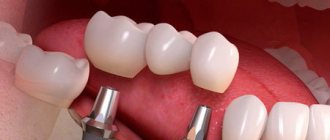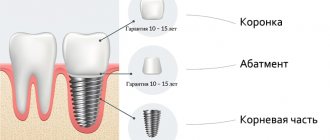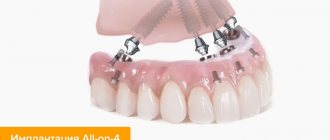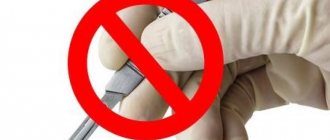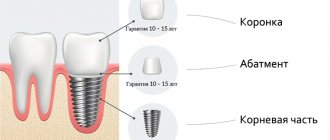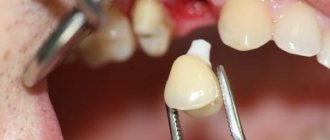Features and advantages of express implantation
Express implantation is becoming more and more popular among patients every year, as it involves inserting an implant into the hole after tooth extraction. The main advantage of this technique is that there is no need to make an incision in the mucous membrane, since there is a ready-made hole that was formed after tooth extraction.
The implant can be installed in the socket after tooth extraction.
In the absence of contraindications to simultaneous implantation, we can talk about a large number of its advantages over the classical method:
- tooth extraction, implantation and installation of a special gum former takes place in one clinic visit,
- the cost is significantly lower than the price of classic dental implantation,
- there is no need for an operation to increase the missing volume of bone tissue, since at the site of tooth extraction the bone tissue simply does not have time to atrophy (this also saves the patient’s money and time),
- It is much more convenient for a specialist to adjust the position and inclination of the implant in a fresh hole, which allows for the most accurate control of the entire process and affects the final result of implantation.
Indications
- the need for urgent correction of the anterior row;
- complete/partial adentia due to loss or abnormal development of teeth;
- narrow alveolar ridge.
Treatment is carried out subject to a number of requirements: absence of inflammatory gum disease, sufficient bone volume, healthy jaw.
Contraindications
:
- pathologies of the heart, blood vessels, blood supply system;
- oncology;
- bruxism (uncontrollable grinding at night);
- mental disorders (Alzheimer's disease, dementia, schizophrenia);
- connective tissue diseases that negatively affect wound healing;
- autoimmune diseases, AIDS;
- allergy to anesthetics.
The flapless technique is a good alternative to the standard technique if the patient is taking anticoagulants or has diabetes. The decision to operate in this case is made by the dentist after a thorough clinical examination and examination of the results of computed tomography. The installation of dental implants is not performed for people with drug/alcohol addiction, pregnant or breastfeeding women.
What is basal implantation?
Expert opinion. Dentist Nemeev S.V. Stars Dental clinic : “Basal implantation also refers to non-surgical methods of restoring the dentition. The technique allows you to implant dental implants even with slight loss (atrophy) of bone tissue, as well as ensure uniform distribution of the load on the jaw bone during chewing. Classical implantation involves the use of screw-type pins consisting of two components (implant and abutment), and basal implants have a special one-component root-like shape and a smooth coating (the implant and abutment are combined) for fixation in the deep parts of the craniofacial bone. This feature allows for basal implantation in cases where the classical method cannot be used.”
Advantages:
- durability,
- the possibility of implanting an implant even with severe atrophy of the jaw bone (the classical method requires increasing the missing bone volume in this case),
- in case of complete edentia, basal implants are a reliable support for fixing removable and non-removable orthodontic structures,
- crowns that are fixed to the basal implant, in case of breakage, must be replaced in one visit to the dentist,
- the rehabilitation period passes quickly, complications develop in very rare cases,
- the cost of basal implantation is several times lower than the price of the classical method.
Important point : basal implantation can be used to restore at least three teeth in a row. Contraindications may become an obstacle to basal implantation. In some cases, after restoration of health, basal implantation becomes possible, but some contraindications are a direct barrier to the implementation of this type of prosthetics:
- pregnancy period,
- mental disorders,
- malignant tumors,
- uncompensated diabetes mellitus,
- blood diseases,
- acute rheumatism.
Methods that allow you to restore teeth using an express protocol
We have already mentioned that the concept of “express implantation” is very broad. Within this technology, there is not one, but many solutions. And this is a significant advantage for patients, because... There is always an option that can be selected to suit the specific clinical case.
We will consider three main approaches, two of which are the highest quality and progressive, and the third is considered outdated and is considered only as a temporary and inferior implantation option.
One-step recovery
Single-stage implantation is carried out when there are indications for removing decayed teeth in the patient’s mouth. Using this method, in one visit to the dentist, you get rid of decayed teeth and install implants in the vacated holes (or next to them, if the edentia is multiple or complete). However, you need to understand that the method has features that make it possible, depending on the clinical situation, to combine it with either a classic two-stage implantation or an express technique.
For example, if only 1 tooth is being restored, the doctor will take into account where it is located and whether the installed artificial root has initial stability. Thus, the upper anterior units can be immediately loaded with a non-removable crown, which will be removed from the bite. But chewing teeth will first have to wear a removable prosthesis, which can be replaced with a non-removable one only after the bone tissue has fused with the body of the implant - this happens after 3-6 months.
Important! Unlike the classical one, the one-step method allows you to perform two operations at the same time: remove teeth and place implants. The advantage is that the patient does not have to go through the surgical stage twice, recover for a long time and build up bone tissue, because immediately after extraction it has a normal volume.
For patients with a large number of decayed teeth that need to be removed (for example, due to periodontitis or periodontal disease), the situation is much more pleasant. Then the one-stage method is combined with an express method, which involves immediate loading with a fixed and functional prosthesis that performs a splinting function.
One-step treatment protocols
Within the framework of one-stage implantation, there are several effective solutions in which the installation of the prosthesis is based on a different number of implants. Thus, with slight bone atrophy, the patient can be offered all-on-3 technologies (only for the lower jaw) and dental prosthetics on 4 implants (for any of the jaws). With an average degree of resorption and the presence of minor inflammatory processes, the all-on-6 complex will help cope with adentia. In more serious clinical situations, with acute atrophy, with generalized inflammation of bone tissue, with osteoporosis and with risk factors (for example, the patient smokes, has diabetes), basal and zygomatic implantation are used.
The term “express” fits all of the above complexes more than ever. Here, a prerequisite for compliance with the treatment protocol is the immediate loading of the installed implants with a prosthesis - as a rule, this is carried out within 2-3 days. But there is also a nuance here: express loading is applicable only if the patient is indicated for the installation of at least 3 artificial roots. Those. the technology works for multiple restorations, when restoring all the teeth in the jaw at once, but for single ones it cannot be recommended (or in rare cases, one might even say ideal).
Mini-implantation as a temporary solution
Installation of short and small-diameter mini-roots also meets the requirements of express implantation, because allows you to carry out the procedure minimally invasively, without unnecessary trauma, and immediately fix the prosthesis. True, such rods are very thin and small, so they can only withstand a removable structure. At the same time, it does not last long - maximum 2-3 years. During their operation, the patient has to deny himself the consumption of his favorite foods and follow a diet, otherwise the entire result of the treatment may go down the drain. There is one more disadvantage: unlike the other two approaches, installing mini-implants in the jaw does not exclude the development of bone atrophy, which subsequently leads to a violation of the aesthetics of the restoration.
The technology is not far removed from prosthetics with conventional removable systems, and its significant advantage over them is only one - reliable fixation of structures. And the prices for treatment are almost the same as for the methods listed above. Therefore, this approach is considered outdated, because if there is almost no difference in price, and the quality of workmanship can be much higher and more durable, why choose something that is objectively worse.
Immediate Load Implantation – InstanTeeth
Non-surgical dental implantation InstanTeeth (teeth immediately or immediately) is an innovative technology in dental prosthetics, a completely new approach to implantation. Even in difficult cases, using the Immediate Load technique, it is possible to implant implants in a short time. This is possible due to the fixation of implants not only in the jawbone, but also in the zygomatic bone, as well as in the counterforms of the skull. Features of IL technology:
- The shape of the implant is suitable for implantation even into atrophied bone tissue.
- The technology allows for prosthetics in any part of the jaw.
- The implant and abutment are one whole.
The abutment and implant in the system are one whole. - In case of severe gum atrophy, the implant can be installed together with artificial gum made from safe hypoallergenic material.
- Possibility of prosthetics after tooth extraction.
- Even with a large absence of teeth, prosthetics are carried out in one visit to the clinic.
- This is the world's first implantation system that allows you to work with all parts of bone tissue.
- The special coating and thread significantly reduce the healing time of the implant.
- Engraftment of the implant into the bone occurs simultaneously with the operation of the prosthesis.
- The doctor selects combinations of different types of implants individually for each patient, taking into account his characteristics.
In the Russian Federation, the Immediate Load implantation method is mainly used on Nobel Biocare, Bio Horizons, Alpha Dent, Osstem, MIS, Roott implants. But the founder of the technology is the Swiss company Ihde Dental, under whose patronage special implants for immediate loading Oneway Biomed were released onto the world market with a lifetime guarantee not only on the implants, but also on the result of implantation itself.
Recommendations for the rehabilitation period
To avoid the risk of complications, patients are advised to:
- Do not eat for the first 2-3 hours after surgery.
- During complete healing, avoid solid food. For the first 2 weeks you should also not eat hot or spicy foods.
- Avoid strenuous physical activity and overwork.
- Avoid sudden temperature changes and overheating.
- Give up cigarettes and alcoholic drinks.
The video shows a diagram of bloodless dental implantation.
Comparison of prosthetic methods
To evaluate all the features, pros and cons of the non-surgical implantation method, we offer you a comparative table of different prosthetic methods:
| One-stage (non-surgical) implantation | Classic implantation method | Traditional prosthetics | |
| Degree of injury | Minimal, no incisions or stitches required. | Requires peeling off a flap of gum to form a place for the implant. | To fix the prosthesis, in most cases it is necessary to grind and remove nerves from adjacent healthy teeth. |
| Duration of treatment | About a week. | From the moment of implantation to the moment of installation of a permanent prosthesis, it can take from 4 to 6 months. | It all depends on the production time of the prosthesis. |
| The need for bone grafting | There is no need for surgery. | In case of atrophy, bone grafting surgery is performed. | — |
| Restoration of chewing function | A few days after implantation, you can load your jaws and chew. | Permanent dentures are installed after 4-6 months, and then normal chewing function resumes. | Immediately after installation of the prosthesis. |
| Aesthetic side | In case of gum atrophy, an artificial gum is installed, which slightly reduces the level of aesthetics. | Thanks to abutments and gum formers, aesthetics are at the highest level. | Depends on the type of prosthesis. |
| Stabilization level | High rates of primary stability. | Reliable stability can be achieved after 4-6 months. after complete engraftment. | For removable structures, stability leaves much to be desired. |
| Life time | Implants usually last for the rest of your life. | Depends on the type of prosthesis. | |
Installation steps
The classical implantation method involves three stages, the non-invasive technique is carried out in two stages:
- gum puncture;
- installation of a crown.
When the gums are punctured, a site for implantation is immediately formed. Using a computer program, the shape of the future structure is modeled. The procedure itself takes 12-15 minutes and does not cause pain to the patient - the manipulations are carried out under local anesthesia. In some cases, the patient receives cosmetic crowns for a short period of time. The second stage is the installation of a ceramic permanent crown.
After puncturing the gums, the hole is widened with special instruments and, if necessary, deepened. Next, the gum former is installed. At home, the patient must follow the dentist’s recommendations—take prescribed medications and not injure the site where dental implants are inserted.
Transgingival implantation
Transgingival implantation means fixation of a dental implant into the bone without cutting the gum mucosa by puncturing it - a small circular incision in the gum using a special instrument. But the incision here is much smaller and looks much neater than with classic implantation. Damage to soft tissue is insignificant, which significantly shortens the healing period. Transgingival implantation occurs in several stages :
Transgingival implantation technique.
- the doctor makes a small circular incision,
- the hole is expanded and deepened to the desired size,
- the doctor installs the implant, controlling the depth and inclination of its insertion,
- then the gum former is fixed.
It is also worth mentioning intramucosal implantation, which is used to improve conditions for fixing removable dentures. Such implants consist of 2 parts: the first is fixed deep into the mucosa, and the second is installed on a removable denture; when connected, they snap into place.
Many names - one technology
In addition to the term “express method,” you may come across the following names on the Internet, on dental advertising posters, in various descriptions, or when talking with doctors: single-stage, single-phase, one-stage, instant, or even instant implantation. All these terms imply the same approach - the process of acquiring new teeth for the patient passes quickly, in one stage, i.e. and direct installation of implants. At the same time, fixation of fixed prostheses on them is carried out almost at the same time, no later than 72 hours after direct implantation, i.e. in three days.
The following names may also appear: bloodless, seamless and minimally invasive. Again, we are not talking about different methods, but about the same approach. It is understood that the procedure for installing artificial roots using express technology is carried out using special surgical guides, through which the rods are implanted into the jaw bone only through a small puncture. Those. the doctor does not need to make incisions, peel off the mucous membrane and suturing it, as is done with classic two-stage implantation. As a result, the patient does not have pronounced pain, bleeding and swelling during the rehabilitation period, even if all teeth in the mouth are restored at once.
There is another name – Immediate Load Implantation. Translated into Russian as “implantation with immediate loading.” Here again, it is implied that the method uses certain models of artificial roots, which, when installed, are highly stable, take root quickly and can immediately withstand the pressure from fully functional prostheses.
Advantages of the non-surgical method
All non-surgical implantation techniques differ slightly, but they all share the following advantages :
- minimal trauma to the mucous membrane,
- the possibility of installing an implant in the hole after tooth extraction,
- restoration of damaged tissues in the shortest possible time,
- the risk of infection and development of the inflammatory process is minimized,
- high survival rate,
- swelling and pain go away after a few days,
- no need for stitches,
- affordable price.
How much does treatment cost?
The price for express dental implantation consists of the cost of implants, dentures (temporary adaptation will be cheaper than permanent ones), this also includes the cost of the work of an implantologist and orthopedist, diagnosis and treatment planning. For example, a single restoration with immediate loading costs at least 35 thousand rubles. Restoration of the chewing segment starts from 130 thousand. The Trefoil method costs about 280 thousand, and the price for all-on-4 and all-on-6 is approximately 350 and 450 thousand, respectively. By the way, similar protocols Pro Arch and TeethXpress will cost about the same amount. Zygomatic implantation costs an average of 500 thousand rubles, and the basal complex costs 250-400 thousand (depending on the brand). You can also save on treatment, for example, if the dentist holds regular promotions or gives discounts to regular customers.
International Clinical Study of Basal Implants, “The Concept of Immediate Functional Loading with One-Piece Implants,” Journal of Evolution of Medical and Dental Sciences, February 2020.
Author: Kopylov I. P. (Thank you for your help in writing the article and the information provided)

